Page 13
Back to the big horizontal Moleskine
I'm still waiting for the Stillman and Birn softcover sketchbooks to come out. The first batch had a problem with the binding so they were all recalled (what a headache for the company, but the fact that they took this action immediately is a testimony to their integrity).
 So while I'm waiting, I decided to go back to a sketchbook which I never thought I'd use again, the large Moleskine Watercolor Album So while I'm waiting, I decided to go back to a sketchbook which I never thought I'd use again, the large Moleskine Watercolor Album . .
I had rejected this several years ago as being too large and unwieldy to hold for on-the-spot sketching, and then several weeks ago, I rejected it as being too large to carry with me everywhere. Now, I'm giving it another chance because it happens to be on hand.
For this drawing, I once again abandoned color and returned to black and white with focus on the lines, especially the hatching. I borrowed several figures from previous color drawings to see how they would look carefully rendered in ink with no color. This drawing had so much detail that I had to upload a considerably bigger image than usual (click on the image below to see the larger image).
With this drawing I experimented with two hatching styles, both done with the same dip pen. One style is more free with exaggerated line variation, and the other is tight and deliberate. I think I prefer a style between these two. Hopefully I can accomplish that in my next drawing.
I used a vintage Soennecken dip pen with Pilot SHOKENYO (document ink) for this. Most artists use Pilot SEIZUYO (drafting ink) for drawing. Both of these inks are well known in Japan and have been around for many years. I won't take up space here to describe how these two inks are different, but for those who are interested, I have written a separate article on the subject called Pilot bottled inks for dip pens.
I actually liked how this drawing turned out in this big horizontal sketchbook. 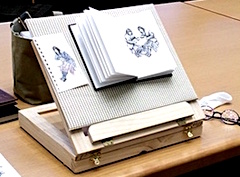 I can draw the figures at a more comfortable size, and stagger their positions a little vertically so they are not standing in a perfect row. I can draw the figures at a more comfortable size, and stagger their positions a little vertically so they are not standing in a perfect row.
But this will be the last drawing in this particular sketchbook because the threads holding the paper together have come unravelled, thanks to my "surgical experiment" when I removed the first signature.
And I don't think I'll buy another large horizontal sketchbook because it's still awkward to draw in, especially at my little desk easel.
I'm constantly rotating the sketchbook to get the best angle for my hand to make the best brush strokes, so part of the long sketchbook is often dangling off the edge of the drawing board, trying to take the rest of the sketchbook with it. Very distracting.
If I ever use larger drawing board, I may go back to this large sketchbook format, but right now my little easel prefers small sketchbooks like the 4X6 inch Alpha in the photo.
Of course, all sketchbooks have a little bit of awkwardness built into them because of their thickness, since your hand must rest on the desk surface which is lower than the drawing surface.
The drawing experience would be a lot easier if I could warm up to using loose sheets of paper instead of a sketchbook -- and I wouldn't have to deal with such issues as which ink will rub off on the facing page.
But as I've written before, there is stronger motivation to draw if I am adding drawings to a real sketchbook because it becomes a precious treasure that increases in value with every new page.
Ideally, the art itself should be sufficient motivation without such props as nice sketchbooks, easels and other art supplies.
A lesson from Hokusai
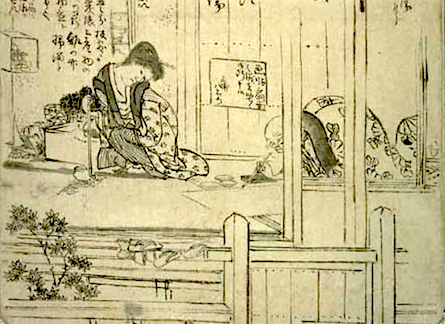 One of my art heroes, Katsushika Hokusai called himself "an old man mad crazy about art" (GAKYO ROJIN) because he was obsessed with drawing. One of my art heroes, Katsushika Hokusai called himself "an old man mad crazy about art" (GAKYO ROJIN) because he was obsessed with drawing.
It was actually his professional name in his final years, and is carved on his grave stone.
To the right is a picture of him which was drawn by one of his disciples, Tsuyuki Kosho (a.k.a. Tsuyuki Iitsu II) five years before Hokusai's death.
He is depicted with his daughter Oe, also an amazing artist.
He had no fancy studio.
He lived in poverty and was constantly moving from one dwelling to another or was a guest in other peoples' homes.
He had no fancy art supplies or sketchbooks.
Once he had to escape a house fire with only a handful of brushes, his most prized possessions, leaving even his drawings behind to burn.
At the end of his life he's living in a humble broken down shack in the same neighborhood where he was born (within walking distance of my home, incidentally).
We see him covered with a FUTON (Japanese thick blanket), hunched over a sheet of paper on the floor with a brush in his hand.
It was said that he would stay under that lice-ridden blanket for weeks during the winter, drawing, sleeping and then drawing again, and wouldn't come out from under it even when he had distinguished visitors.
Hokusai was so driven to draw that he could endure cold, poverty and great discomfort. He didn't need a fancy sketchbook or other art supplies to keep him motivated.
On his deathbed at the age of 88 or 89, he pleaded with heaven to grant him ten more years -- or even just five -- so that he could continue to draw and improve his art.
He truly was "an old man mad crazy about art."
At the Edo-Tokyo Museum you can see a miniature diorama which is based on the drawing.
And at the Sumida Hokusai Museum which opened in November of 2016 you can see an amazing life-size display of this same scene.
But, I'm not Hokusai. The thrill of seeing art that my hands have produced on loose sheets of paper is apparently not enough to keep me motivated to draw all the time. I tried it for several weeks, drawing on loose cards, both postcards and 3X5 index cards. They are very convenient and portable, and I had every reason to draw even more, since all the awkwardness associated with sketchbooks had been removed. But instead, my drawing activity slowed down and nearly stopped for lack of motivation.
(This only affected my ink drawing; my quick pencil and watercolor sketches continued at the same pace as always this since this activity is built into my schedule as I ride home the evening train with a sketch notebook in my pocket.)
I think the issue has something to do with constantly starting a new ink drawing on a new, blank card, which is always a little bit daunting. On loose cards, I can only fit a few figures onto each drawing, and then I have to begin a new card which is unrelated to the one I finished, and it's hard to get started. And the shuffling of cards, replacing old card with new ones introduces a new awkwardness that doesn't exist with sketchbooks.
On the other hand, in a sketchbook, after that first plunge, each additional figure adds to the excitement, and I look forward to completing the drawing. And every new page is simply a continuation of the same project. Anyway, that's how my brain apparently works, so why fight it?
And I keep coming back to the same conclusion that of all my ink drawings, the ones which seem to amaze people are the horizontal (landscape orientation) ones filled with people. So a horizontal sketchbook seems to be my ticket to adventure. Even with all the awkwardness of using a horizontal sketchbook, it appears I will just have to live with it.
A new Moleskine project
Since I'm still waiting for the new Stillman and Birn Epsilon or Zeta horizontal pocket size horizontal softcover sketchbooks to come out, I decided to get a new Moleskine Watercolor Album and get back into the groove. and get back into the groove.
My collection of subway passenger pencil and watercolor sketches had continued to grow in the meantime (I have many small notebooks packed with them now) so I had no lack of subjects to draw in ink.
Here are a few of the more interesting ones. Like the others, these are 3X5 inch sketches, done within a few minutes on a moving train.
And here is the drawing done entirely in brush and ink in my new Moleskine sketchbook. Click on the image to see a larger one.
Below are the quick sketches arranged in the same order as they appear in the ink drawing. You'll notice that I took many liberties when drawing them in ink. You'll also noticed that one figure is missing. When it came time to take photos, somehow I couldn't locate it among my other recent sketches.
I was so happy to be sketching -- and drawing -- regularly again and having a great time. What a difference the right sketchbook can make -- for some people!
Unfortunately, when I began drawing a new set of figures on the next two-page spread, the carbon ink lines feathered out and made tiny spidery lines! Apparently this paper was not the same as the Moleskine watercolor paper they had produced in the past, and it was even different from the first page of the same sketchbook! I drew several more figures just in case it was an isolated case caused by skin oils which had rubbed onto the paper, but the ink lines feathered out wherever I drew on the page.
So I switched to Kuretake ink in my Yume Ginga brush pen, which is more dry and less likely to feather. As expected, it did not feather at all. But when I erased the underlying pencil lines the next day, much of the Kuretake ink also came up, leaving a gray line behind. This had never happened with Kuretake Sumi ink before, so I have to assume it is a problem with the paper.
After all these years of enjoying the quality of Moleskine's watercolor paper, it came as quite a shock that the paper was no longer the same. Apparently the company has started using new paper, and did not take ink drawing into consideration.
So I removed my few drawings from this new Moleskine watercolor album, and then threw it in the trash, and my new Moleskine project contained one complete drawing (above) and one partial drawing with spidery and gray lines.
A dream drawing?
I had determined that my ink drawings of people on the subway look best when arranged in groups in a small horizontal sketchbook, but now there was no horizontal sketchbook with decent paper for ink available, at least until Stillman and Birn produces the next batch of softcover horizontal Epsilon and Zeta sketchbooks.
I still had one Stillman and Birn pocket sketchbook which was vertical (portrait orientation) and it had Epsilon paper, so I decided to use it until a good horizontal sketchbook became available, but it would be a challenge to go back to this small vertical format.
During the night just before dawn while I was still alseep, I had a dream about an ink drawing. Seriously!
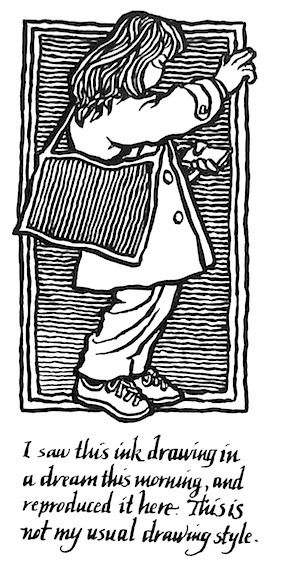 It was a vivid, detailed image of a girl carrying a bag. Her height was shorter than what would be expected. It was a vivid, detailed image of a girl carrying a bag. Her height was shorter than what would be expected.
The ink lines were crudely drawn in a jaggedy, angular style, and all the outlines were very bold although the hatching was done in thinner lines.
There was also a border touching the subject on all sides.
In the dream, I could zoom in and see the hatch lines in great detail.
This image was drawn in a style different from my own, but the proportions and subject matter would fit nicely in my pocket Epsilon sketchbook.
So after I awoke, I wrote the details of the image in my journal, and later in the day, attempted to reproduce the image on paper.
I figured that if my mind had produced the image once in a dream, then it should be able to produce it again on paper.
The biggest problem is not having a subject in front of me.
Drawing the contents of a dream from memory is essentially the same as drawing from imagination, which I find very difficult.
So I flipped through my pencil and watercolor sketches and found a sketch of a girl with basically the same pose as the drawing in my dream.
I had made the sketch in the previous week.
Then I got out my brush pen and attempted to reproduce the drawing, but I couldn't get the same line quality as the one in the dream.
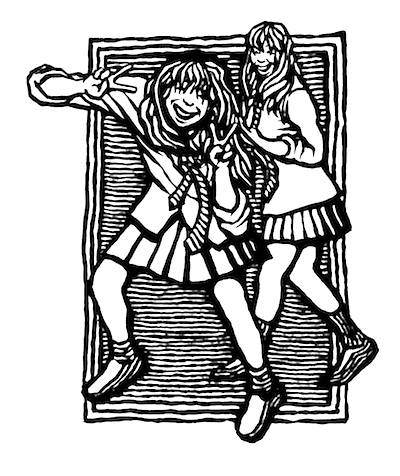 So I took out a flexible nib fountain pen and tried it again, and this time it came very close to the dream drawing. So I took out a flexible nib fountain pen and tried it again, and this time it came very close to the dream drawing.
Next, I brought my dip pen out and proceeded to make a careful drawing.
That's the drawing to the left, and it looks remarkably like the one in my dream, except this girl may be a little taller.
The size is 3.5 X 5.5 inches (approximately 89mm X 140mm).
I made a few more drawings in this new style, including the one to the right, of some of my students who were getting ready to give a dance performance at school, and were full of energy.
This drawing was loosely based on a photo (which was taken by another student who took my tablet and started freely snapping photos of her classmates). Nobody would be able to hold such an interesting pose long enough for me to capture it in a sketch!
As I looked at these curious drawings, my immediate thought was that this style would be well suited for religious illustrations for reproduction.
This was actually something I had been considering for some time, and I wondered if and when I would ever find myself doing this type of artwork.
Well, it didn't take long for me to figure out; withiin a few weeks I received a request from the Secular Discalced Carmelite community in Conyers, Georgia in America for some illustrations for a brown scapular which they were planning to produce and distribute.
I knew the time had come for me to put this new style to action, and below are two of the designs I submitted to them, plus a sample of the finished product which arrived in the mail several weeks later. They were very happy with these, and liked the style in which I drew them. What amazing timing!
About a year and a half later they got back to me and said that they had already made 17,000 scapulars with these illustrations (averaging about 1,000 scapulars a month) and had even presented one to Pope Francis. So what had started out as an unusual dream certainly went a long way, all the way to the Pope!
Sketching with a 0.7 pencil
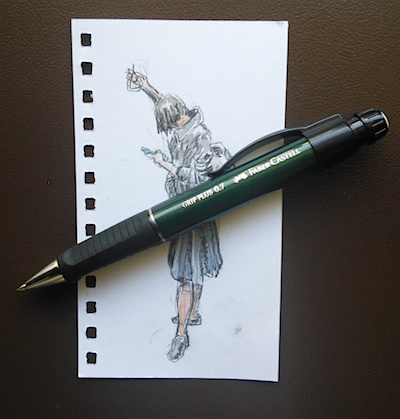 Back to my pencil and watercolor sketches, I decided to give the 0.3 mm leads a break and try 0.7 for a while. Back to my pencil and watercolor sketches, I decided to give the 0.3 mm leads a break and try 0.7 for a while.
The main reason was that I had been searching for a way to reduce the number of writing implements in my shirt pocket; I was carrying a pencil for sketching, a waterbrush for coloring the sketches, a brush pen for drawing in ink, a fountain pen for writing and jotting, and a stylus for typing accurately on my tablet.
I was hoping to find something that combined the pencil and stylus at least.
I ended up getting a Troika Construction Mechanical Pencil  which had a stylus on the end, and it came with a 0.7 lead. which had a stylus on the end, and it came with a 0.7 lead.
 
The stylus worked very well, and I loved the ruler which was printed on the barrel (I sometimes carry a ruler in my pocket, too!) butI had been using 0.3 leads for so long, that my first attempts with the 0.7 were very clumsy.
I sketched with the Troika pencil for several weeks and gradually warmed up to the thicker 0.7 lead.
The first few sketches were done in pretty much the same style as I had been using with 0.3 leads, as you can see in the top row of three sketches.
I must confess that I finally put the Troika pencil away because although it was really cool, the twist mechanism to extend the lead requires two hands, and interferes with sketching.
However, by this time I was hooked on 0.7 leads!
So I started using a Faber-Castell Pencil GRIP PLUS 07 with Green Metallic finish which is much easier to use, and it has a nice big retractable eraser. And I love how it looks. which is much easier to use, and it has a nice big retractable eraser. And I love how it looks.
(You can also see all my spiral bound "butterfly net" sketches on one page in one big collection.)
As I used this pencil, I gradually loosened up, and got a more free line, similar to a brush. My watercolor also started to loosen up and I was doing more than just filling areas with flat color, as you can see in the bottom row of three sketches.
This has given new life to my sketches. They are not as tight as before, and are therefore not as useful as models for ink drawings done later, but they are more atractive in their own right.
| 


